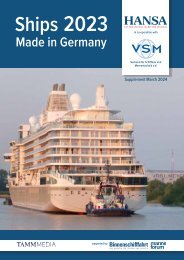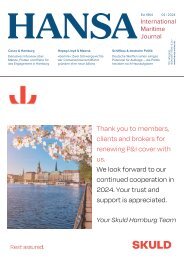HANSA 05-2019
Nor-Shipping ’19 | Maritime Hub Norway | Finanzplatz Oslo | Tugs & Salvage | HullPIC | Offshore-Logistik | NordLB | Breakbulk Europe | Hansa Heavy Lift | HS Schiffahrt | MPP-Carrier
Nor-Shipping ’19 | Maritime Hub Norway | Finanzplatz Oslo | Tugs & Salvage | HullPIC | Offshore-Logistik | NordLB | Breakbulk Europe | Hansa Heavy Lift | HS Schiffahrt | MPP-Carrier
You also want an ePaper? Increase the reach of your titles
YUMPU automatically turns print PDFs into web optimized ePapers that Google loves.
Tech-Hub<br />
<strong>HANSA</strong> TECH-HUB<br />
ORTLINGHAUS<br />
Driving propeller and firefighting pump with same main engine<br />
FiFi pumps have become a standard requirement<br />
in new tugboats. How to find an economical solution<br />
without compromising manoeuverability? Clutch maker<br />
Ortlinghaus proposes one main engine to drive the<br />
© Ortlinghaus<br />
propeller and the FiFi pump. Space can be saved, as no<br />
separate engine is needed. During firefighting operation<br />
the pump needs full power while the propeller provides<br />
a certain level of thrust. This task can be realised with a<br />
FiFi pump connected to the B-side of the main engine<br />
and a slipping clutch between the diesel and propeller<br />
side, providing only part of the power to the propeller.<br />
With high-speed engines this becomes a challenge. Ortlinghaus<br />
has developed system solutions with a friction<br />
clutch that permit thermally controlled full slip at high<br />
speeds. Propact 75 HD Ortlinghaus is able to slip up to<br />
nominal speed of high-speed engines, Propact 72 MD,<br />
can be used to slip up to medium speeds.<br />
DAMEN<br />
Rudder and steering gear system for ice breaker<br />
Damen Marine Components (DMC) has completed<br />
supply and installation of a number of critical systems for<br />
the Antarctic Supply Research Vessel (ASRV) »Nuyina« for<br />
the Australian government. These had to be fabricated to exceptionally<br />
high standards to cope with the ice in the Southern<br />
Ocean. DMC, under its Van der Velden Marine Systems<br />
brand, is responsible for the detail engineering and manufacturing<br />
of the rudder and steering gear system. The rudders<br />
have been designed and engineered by project-lead Damen<br />
Schelde Naval Shipbuilding as free-hanging, full-spade rudders.<br />
They deliver optimum hydrodynamic properties but<br />
until now were unheard-of for an icebreaking vessel of this<br />
class, given the forces involved. Other innovative features<br />
include integrated mechanical rudder stoppers, which are<br />
located between the rudder blade and (hull) skeg structure<br />
rather than on the outside hull due to the latter’s radical design.<br />
To deliver all the necessary steering system components<br />
from the bridge to the rudder, including hydraulics,<br />
control and power systems, DMC pooled its expertise in this<br />
field with that of MacGregor Hatlapa (MacGregor).<br />
• Drahtseile • Tauwerk • Festmacher<br />
• CASAR Bordkranseile • Anschlagmittel<br />
• Prüflasttest bis 1.000 t<br />
• Segelmacherei • Taklerei • Montage<br />
Walter Hering KG<br />
Porgesring 25<br />
22113 Hamburg<br />
Telefon: 040 – 73 61 72 -0<br />
eMail: info@seil-hering.de<br />
www.seil-hering.de<br />
WINGD/EXXON MOBIL<br />
Focus on smart shipping<br />
WinGD and ExxonMobil have announced a collaboration<br />
to assist ship operators with engine maintenance.<br />
This will be done with the help of analysis and monitoring<br />
tools. The key objective is to merge WiGD’s Integrated Digital<br />
Expert (WiDE) maintenance technology with ExxonMobil’s<br />
Mobile Server Cylinder Condition Monitoring service.<br />
Gathering knowledge about the functioning of a ship’s engine<br />
is more important than ever to ensure safe and efficient<br />
engine operation. According to the companies, with Mobile<br />
Server Cylinder Conditioning Monitoring, the sulphur content<br />
in marine fuel can be measured throughout the refuelling<br />
system and at engine entry. This can help ship owners<br />
to ensure IMO compliance.<br />
48 <strong>HANSA</strong> International Maritime Journal <strong>05</strong> | <strong>2019</strong>


















